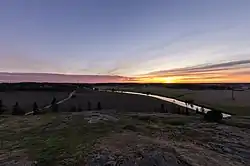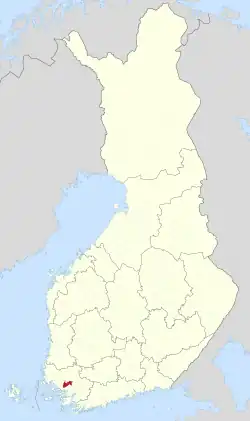Lieto
Lieto (Finnish pronunciation: [ˈlie̯to]; Swedish: Lundo) is a a city and municipality of Finland.
Lieto
Lundo | |
|---|---|
City | |
| Liedon kaupunki Lundo stad | |
 | |
 Coat of arms | |
 Location of Lieto in Finland | |
| Coordinates: 60°30.3′N 022°27.5′E | |
| Country | |
| Region | Southwest Finland |
| Sub-region | Turku sub-region |
| Founded | 1331 |
| Government | |
| • City manager | Mika Ingi |
| Area (2018-01-01)[1] | |
| • Total | 302.56 km2 (116.82 sq mi) |
| • Land | 198.51 km2 (76.65 sq mi) |
| • Water | 1.66 km2 (0.64 sq mi) |
| • Rank | 235th largest in Finland |
| Population (2023-10-26)[2] | |
| • Total | 20,506 |
| • Rank | 52nd largest in Finland |
| • Density | 103.3/km2 (268/sq mi) |
| Population by native language | |
| • Finnish | 94.4% (official) |
| • Swedish | 1.5% |
| • Others | 4.1% |
| Population by age | |
| • 0 to 14 | 19.5% |
| • 15 to 64 | 60.8% |
| • 65 or older | 19.7% |
| Time zone | UTC+02:00 (EET) |
| • Summer (DST) | UTC+03:00 (EEST) |
| Climate | Dfb |
| Website | www.lieto.fi |
It is located in the province of Western Finland and is part of the Southwest Finland region. The municipality has a population of 20,506 (26 October 2023)[2] and covers an area of 302.56 square kilometres (116.82 sq mi) of which 1.66 km2 (0.64 sq mi) is water.[1] The population density is 103.3 inhabitants per square kilometre (268/sq mi).
Neighbour municipalities are Aura, Kaarina, Marttila, Paimio, Pöytyä and Turku.
The city is unilingually Finnish.
Lieto has a medieval stone church, St. Peter's church, that originates from around 1500 near the city center.
The city is also home to the largest local scout troop in Finland, called LEK or Liedon Eränkävijät.
Lieto was changed to a city in July 2022.
References
- "Area of Finnish Municipalities 1.1.2018" (PDF). National Land Survey of Finland. Retrieved 30 January 2018.
- "Preliminary population statistics 2023, September". StatFin. Statistics Finland. Retrieved 26 October 2023.
- "Demographic Structure by area as of 31 December 2022". Statistics Finland's PX-Web databases. Statistics Finland. Retrieved 6 September 2023.
- "Population according to age (1-year) and sex by area and the regional division of each statistical reference year, 2003–2020". StatFin. Statistics Finland. Retrieved 2 May 2021.
External links
 Media related to Lieto at Wikimedia Commons
Media related to Lieto at Wikimedia Commons- Municipality of Lieto – Official website
- Danish Media Company - Lieto – Website
- St. Peter's Church in Lieto (in Finnish)
